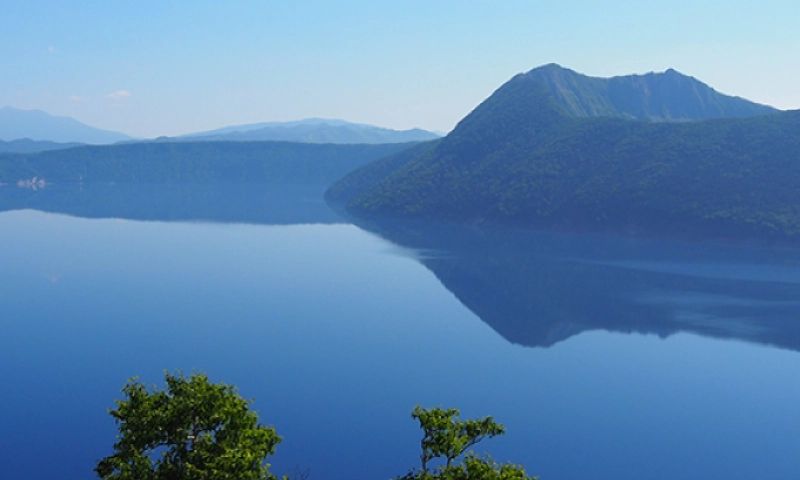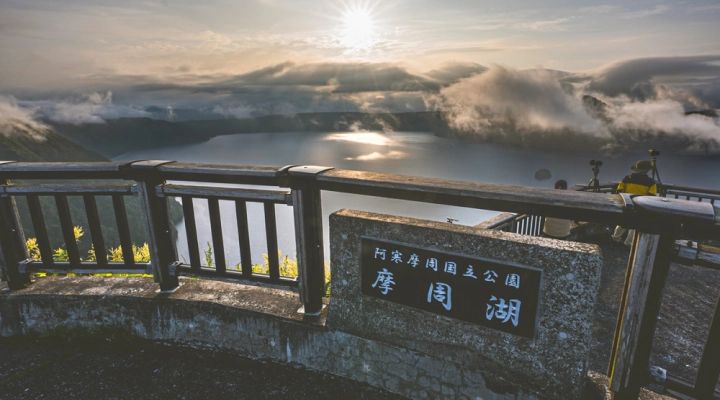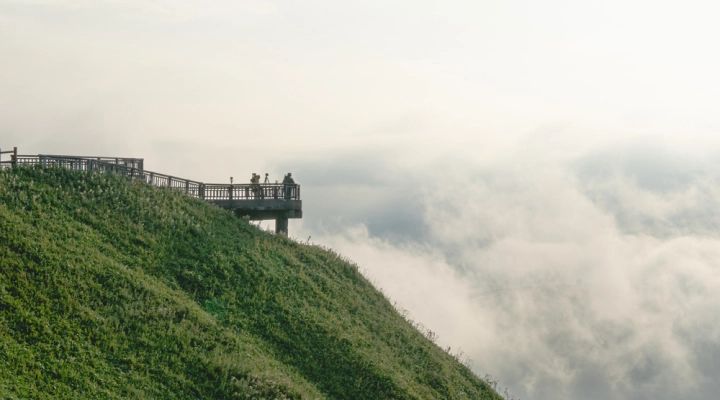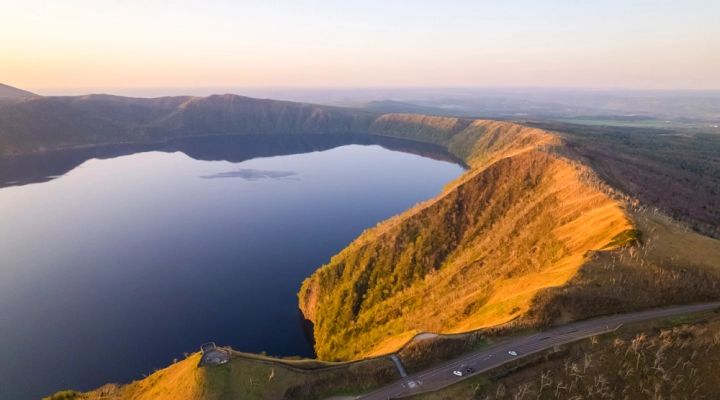Explore Lake Mashu's Dazzling 'Mashu Blue'!
Enjoy Nearby Camping and Hot Springs!
Enjoy Nearby Camping and Hot Springs!
Publication Date:2024.09.01
Last Updated:2025.05.23

Contents
01
Basic Information about Lake Mashu

Located about 1 hour and 40 minutes north by car from the port
city of Kushiro, which represents eastern Hokkaido, Lake Mashu is
situated within the eastern side of Akan-Mashu National Park in
the town of Teshikaga. Lake Mashu is a caldera lake formed by
volcanic activity. Despite being surrounded by caldera walls and
lacking any inflowing rivers, the lake mysteriously maintains its
water level. Known for its high transparency, Lake Mashu was named
a Hokkaido Heritage Site in 2001, and is famous for having the
highest water clarity in Japan. The 41.6-meter transparency
recorded in 1931 remains an unbroken world record. The lake's
stunning blue surface, known as "Mashu Blue," is a popular photo
spot. Additionally, Lake Mashu is also called "Foggy Lake Mashu,"
with a mystical fog enveloping the area approximately 100 days a
year. If you're lucky, you might also witness the sea of clouds
covering the lake.
02
Discover Seasonal Highlights
Lake Mashu changes its appearance with each season. In spring,
after the snow melts, cycling is recommended from around May when
you can enjoy the fresh air of new greenery. There's also a chance
to spot wildlife such as Ezo deer, red foxes, and Ezo squirrels as
they become more active. In summer, climbing Mount Mashu is
popular, offering breathtaking views of Lake Mashu from the
heights. Known as the "Foggy Lake Mashu," the lake is often
shrouded in mist from June to August, so catching a clear view
might depend on your luck. Additionally, during this period,
visiting early in the morning might give you the rare opportunity
to see a sea of clouds. In autumn, the trees change colors, and
you can enjoy Lake Mashu enveloped in vibrant autumn foliage. It's
a great time to observe the beautiful, sparkling night sky in the
crisp autumn air. In winter, snowshoe hiking allows you to
experience views of Lake Mashu that can't be seen from the
observatories.
03
Enjoying Lake Mashu from the Observatory

There are three observation decks set up at Lake Mashu, each
offering a different view of the lake.
1.Lake Mashu First Observatory
Located along Route 52, this is the main observatory accessible
even during snowy winters. It offers a panoramic view of Lake
Mashu surrounded by trees. At night, you can enjoy the
star-filled sky in the clear air, making it enjoyable at any
time. In the summer of 2022, the "Mashu Lake Kamui Terrace"
reopened after renovations, where you can buy souvenirs and
learn about Lake Mashu through exhibits.
2.Lake Mashu Third Observatory
Located about 4 km north of the First Observatory, this
observatory is at an elevation of 670 meters, the highest among
the three. It offers a close view of Kamui Island, the only
island floating in Lake Mashu. With about ten free parking
spaces, it is less crowded than the First Observatory, allowing
for a more peaceful viewing experience. Note that the road is
closed due to snow from late October to early April, making it
inaccessible by car during this period.
3.Uramashu Observatory (Back Side Observatory)
Positioned approximately 4 km from Kiyosato Pass, this
observatory is on the opposite side of the First and Third
Observatories. Known as "Uramashu Observatory" due to its
location on the reverse side, it offers a different perspective
of Lake Mashu compared to the other two observatories. Here,
Mashu Mountain is close by, presenting a unique view where the
gentle green slopes blend with the mountain's back side. Being a
lower-altitude observatory, fog occurrences are relatively rare,
allowing visitors to enjoy clear views of Lake Mashu. Please
note that this observatory is also subject to road closures
during the winter season.
04
Surrounding Spots around Lake Mashu
The area around Lake Mashu is rich with scenic tourist spots and
hot springs formed by volcanic activity. Here are some of the most
popular spots you can explore around Lake Mashu.
1.Kaminoko Pond (Child of God Pond)
Located about 50 minutes by car from Lake Mashu, the mystical
lake known as Kaminoko Pond is a fascinating site. Named "Child
of God" due to the legend that it was formed by the subterranean
water of Lake Mashu, referred to as the "God's Lake," this pond
is known for its remarkably clear, blue water. It's intriguing
to observe fallen trees preserved at the bottom of the pond
without decaying. With a flow of 12,000 tons of water per day,
the pond remains unfrozen even in winter, offering a mystical
view year-round. Since it's located in the heart of nature,
don't forget insect repellent in the summer. There's nearby
parking, so you won't need to walk extensively either.
2.Kawayu Onsen
Situated within Akan-Mashu National Park, Kawayu Onsen is
renowned for its quality hot springs. The strong acidic waters
emerge from the nearby active volcano, Mount Iou, providing
gentle relaxation for weary tourists. At the "Sunayu" (sand hot
spring), which is a tourist attraction, digging about 10cm into
the sand facing the lake reveals a warm spring. You can enjoy
creating your own hand or foot bath. During winter, when the
water temperature remains high at Sunayu, you may see resting
swans. With activities like boat rentals and camping grounds
nearby, the area is popular among families too.
Okku Outdoor Challenge (Enjoy Cycling around Kawayu's Mount
Io!)
There's also a guided cycling tour departing from Kawayu Onsen
town. Even those without cycling experience can participate
comfortably, making it a recommended tour for couples.
3.Lake Kussharo
Lake Kussharo, located in the town of Teshikaga, is Japan's
largest caldera lake. Known for its crystal-clear beautiful
waters, about 80% of its water source is said to be spring
water. Among the attractions, Wakoto Peninsula on the southern
side of Lake Kussharo is a popular spot visited by tourists and
campers from all over the country. Here are some highlights of
Wakoto Peninsula:
1.Campgrounds
Wakoto Peninsula is highly popular among campers due to its
vast natural scenery and the opportunity to camp while
enjoying the lake. Let me introduce a popular camping
facility:
Wakoto Lakeside Campfield
A campground where you can set up tents facing the shores of
Lake Kussharo. It's an ideal location for enjoying water
activities and stunning views while camping.
2.Canoeing, SUP, and Boat Experiences
Guided canoe tours and SUP experiences allow you to enjoy the
seasonal landscapes from the lake. You can also ride nostalgic
pedal-powered swan boats. The breathtaking views of nature
from your board are simply spectacular. Additionally, you can
enjoy activities like lure fishing and fly fishing.
Kussharo Lake SUP CLUB ([2-Hour Course] Kussharo Lake SUP
Tour)
Embark on an adventure amidst the great nature at Japan’s
largest caldera lake, Kussharo Lake! This lake allows you to
experience volcanic activity up close, featuring elements of
hot springs, geothermal heat, and caldera formations. Enjoy
the abundant blessings of nature through the SUP experience!
3.Dairy Farming Experience
The dairy farming experience during the green season from late
April to around October is highly recommended. Activities
include riding a tractor to explore the vast grasslands at the
foot of Mount Mashu, feeding cows, experiencing milking, and
making butter and ice cream—these activities are unique to
this area. It's a great way to create family memories.
Watanabe Experience Farm (Milking Experience and Tractor
Grassland Tour)
Located in eastern Hokkaido near Lake Mashu and Lake Kussharo,
Watanabe Experience Farm offers 70 hectares of land and 120
dairy cows amidst the grasslands at the foot of Mount Mashu.
It's a wonderful place to interact with adorable cows. This
plan includes activities such as milking, tasting milk,
feeding cows, and a tractor tour through the grasslands.
4.Bihoro Pass
The stunning view of Lake Kussharo from the Bihoro Pass
observatory along Route 243 is hailed as a "superb view of the
world" and is a popular spot for visitors. Tourists from all
over come to capture photos of the majestic scenery featuring
mountain ranges and the peaks of Daisetsuzan. The roadside
station "Gurutto Panorama Bihoro Pass," which was renovated in
2022, offers local delicacies such as fried potatoes and roasted
Ezo deer bowls, as well as opportunities to buy souvenirs.
In eastern Hokkaido, there are guided tour buses available that take you to the Mashu Lake area.
In eastern Hokkaido, there are guided tour buses available that take you to the Mashu Lake area.
<Available from Kushiro City>
Akan Bus Pirika-go
This guided tour bus allows you to visit Lake Mashu, Lake
Kussharo, and Lake Akan all in one day. You can also get off
midway at Akan Lake Onsen or Kushiro Airport. It's an easy way
to enjoy the three major lakes of eastern Hokkaido.
Akan Bus Kushiro Shiretoko-go
This guided tour bus connects Akan Mashu Park and Shiretoko
National Park. After enjoying Lake Mashu, Mount Iou, and
Sunayu, the bus takes you through Bihoro Pass to Shiretoko and
Utoro Onsen. You can also get off at some sections along the
route.
<Available from Utoro Onsen>
Akan Bus Shiretoko Kushiro-go
This bus operates on the reverse route of the above. It's a
convenient guided tour bus that you can use for the round
trip.
05
Access Information
Here are the access methods if you are traveling on your own.
*Please note that these are just examples.
*Please note that these are just examples.
From Kushiro City:
1.Bus
Take the guided tour bus "Pirika-go" from the Kushiro Station
Bus Terminal.
Includes sightseeing at other spots, approximately 9 hours / 5,600 yen for getting on and off within Kushiro City.
Includes sightseeing at other spots, approximately 9 hours / 5,600 yen for getting on and off within Kushiro City.
2.JR
Board the "Senmo Main Line" from Kushiro Station and get off
at Mashu Station.
Approximately 1 hour and 20 minutes / 1,890 yen one-way.
Approximately 1 hour and 20 minutes / 1,890 yen one-way.
3.Rental Car
Depart from Kushiro city center and stop at the Lake Mashu
First Observatory.
Approximately 1 hour and 40 minutes / Cost depends on the rental car company.
Approximately 1 hour and 40 minutes / Cost depends on the rental car company.
From Tancho Kushiro Airport:
1.Bus & JR
Take the Akan Bus "Kushiro Airport Shuttle Bus" and get off at
Kushiro Station.
Approximately 45 minutes / 950 yen one-way.
From Kushiro Station, board the "Senmo Main Line" and get off at Mashu Station.
Approximately 1 hour and 20 minutes / 1,890 yen one-way.
Approximately 45 minutes / 950 yen one-way.
From Kushiro Station, board the "Senmo Main Line" and get off at Mashu Station.
Approximately 1 hour and 20 minutes / 1,890 yen one-way.
2.Rental Car
Depart from Kushiro Airport, travel via Tsuruimura (Route 53),
and stop at the Lake Mashu First Observatory.
Approximately 90 minutes / Cost depends on the rental car company.
Approximately 90 minutes / Cost depends on the rental car company.
Access from Lake Mashu to Surrounding Areas:
1.Kaminoko Pond
Travel by car is common.
Travel via Route 52 and National Route 391, and stop at the Kaminoko Pond parking lot (approximately 55 minutes).
Travel via Route 52 and National Route 391, and stop at the Kaminoko Pond parking lot (approximately 55 minutes).
2.Kawayu Onsen
Take the Akan Bus "Biruwa Line" and get off at "Kawayu
Ekidori."
Approximately 30 minutes / 570 yen.
Approximately 30 minutes / 570 yen.
3.Lake Kussharo/Wakoto Peninsula
Bus: Use the Mashu-Kussharo Tour Bus ticket, board the
Kussharo Bus at "Lake Mashu First Observatory," and get off at
"Wakoto Peninsula."
Approximately 1 hour and 40 minutes / 2,000 yen.
Car: Travel via Route 52 and National Route 243, and stop at the Wakoto Field House (approximately 27 minutes).
Approximately 1 hour and 40 minutes / 2,000 yen.
Car: Travel via Route 52 and National Route 243, and stop at the Wakoto Field House (approximately 27 minutes).
4.Bihoro Pass
Travel by car is common.
Travel via National Route 243 and stop at the roadside station "Gurutto Panorama Bihoro Pass" (approximately 38 minutes).
Travel via National Route 243 and stop at the roadside station "Gurutto Panorama Bihoro Pass" (approximately 38 minutes).
06
Summary

Lake Mashu is renowned for its mesmerizing deep blue waters that
seem to draw you in. The lake is surrounded by steep cliffs, which
makes it an enigmatic place where people cannot easily enter. On
clear days, visitors can enjoy the striking contrast between the
pristine lake and the surrounding forest, while on foggy days, the
lake takes on an ethereal appearance as it seems to float
mysteriously. This ability to showcase different aspects depending
on the timing continues to captivate those who visit.
Additionally, its convenient accessibility allows you to explore
nearby tourist spots with just a short detour. Why not take a trip
to this mystical lake yourself?
Writer Information

Naeka Okumura
Naeka Okumura, born in 1994, hails from Kitami City, Hokkaido. Worked for six years at a financial institution within Hokkaido. Later joined a video production company, Hokuei Northern Films, in Kitami City as a chief manager and writer. Resigned in 2023 and became independent as a copywriter and journalist writer under the name Produce One.
Naeka Okumura, born in 1994, hails from Kitami City, Hokkaido. Worked for six years at a financial institution within Hokkaido. Later joined a video production company, Hokuei Northern Films, in Kitami City as a chief manager and writer. Resigned in 2023 and became independent as a copywriter and journalist writer under the name Produce One.